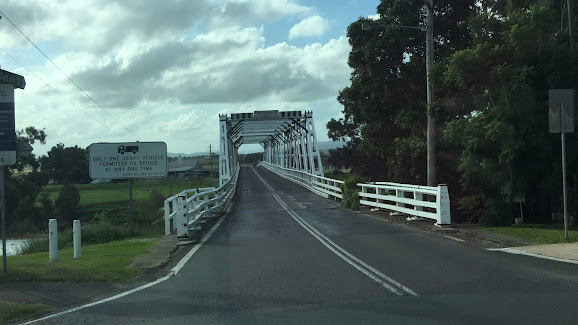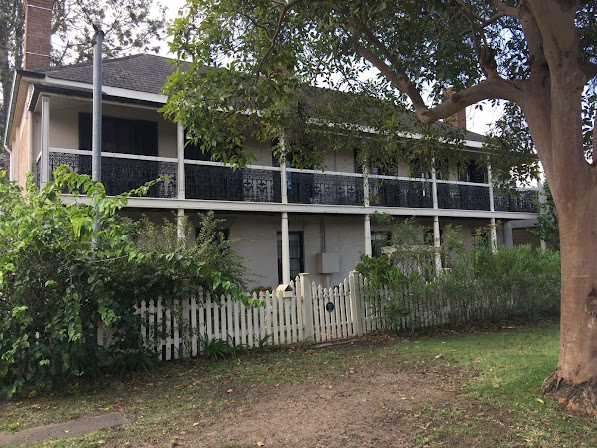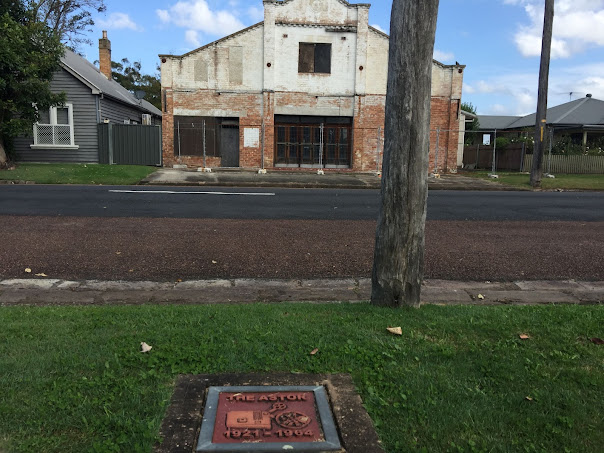The tiny town of Morpeth, N.S.W., located on the Hunter River in the Upper Hunter Valley, was where my ancestors decided to live when James Perrett immigrated to Australia with his wife Sarah, and 9 children in 1839. We have visited the Hunter Valley numerous times, usually on the way to somewhere else, but this time we are 'filling in' time before going to the Tamworth Country Music Festival, we decided to explore the Maitland area. We had lunch at Queens Wharf, or rather where Queens Wharf once was. There had been a lot of rain the past month and the park was still very muddy, so we ate in the car park. Queens Wharf was first established in 1833 as part of the development of many ports radiating from Sydney to provide transport routes for goods and people.
We then drove up to the main street, Swan Street, parked and walked around. There is a really good Heritage Walk issued by the Maitland City Council. Walking the streets one can see many Georgian and Victorian grand houses, now mostly restored or being restored private residences.
Morpeth was very important in the development of the Hunter Valley, and the development of developing regional NSW. Located on one of the important river systems north of Sydney, Morpeth became a major transport centre that led to development of industry and agricultural markets. The first Europeans was the party of Lt Col. Paterson who explored the area in 1801. Patterson named the area Green Hills. In 1821, as a reward for duty during the Napoleonic Wars, Lt Edward Close was granted land in the area, and he built a grand house in 1826 named Closebourne, that still stands today. The first paddle steamer, Sophia Jane, reached the port in 1831, and this was the beginning of the regular steamer service. In 1834, Green Hills was renamed Morpeth. The name Green Hills can still be seen today in industry names, suburbs and streets. Lt. Close also built the first school in 1836, and one of the original brick buildings is still in use today.
Most development happened between 1837 - 1840 with St James Church, on Tank Street, now being heritage listed. Built from local sandstone by Lt. Close on his land. Some of my ancestors were married there. Only the tower is remaining from the original church.
An interesting story about pharmacist Caleb Soul, who managed a pharmacy on Swan Street - Caleb of Soul Pattison fame! Some websites say he managed the store in the 1840's and had built the house across the road in 1822. I don't think either is true.
Caleb Soul was born in London in 1817 and came to Australia about 1863 and managed a store at Morpeth with his son Washington Soul. They relocated to Pitt Sydney in 1872. (information from:G. P. Walsh, 'Soul, Caleb (1817–1894)', Australian Dictionary of Biography, National Centre of Biography, Australian National University, https://adb.anu.edu.au/biography/soul-caleb-4624/text7615, published first in hardcopy 1976.)
Caleb and his son Washington made their famous talcum powder in the shop that they managed, which was the Taylor's Bonded Store. It was also said that Caleb made the strongest rum in the colony - must have been for medicinal purposes😊. Built in 1850, Taylor's Bonded Store is across the road from the Courthouse/ Museum. The CBC Bank was originally in this sandstone building.
Caleb lived down the road on the corner of Swan and Berkley, in a lovely early Pioneer/Victorian house, now a boutique hotel The Bronte. Caleb Soul did not have the house built as it was built about 1822 and Caleb was 5 years old and living with his parents in London.
I think Morpeth is most famous (other than where my ancestors first lived in Australia 😊) for the beginnings of Arnotts Biscuits. William Arnott and his brother David set up their first bakery on Swan Street, Morpeth in 1862. They rented a shop built in 1851 right on the river. The sandstone bakery is still being restored with the help of the Arnott brothers decendants, and today is famous for Sourdough, and owned by the Arnott family. Like many shops it was closed on the day we visited, Tuesday, but we didn't mind as less people were around.
1866 Morpeth became a municipality and had 10 hotels. over a hundred years later, 1969, Morpeth became a suburb of Maitland.
Another interesting story begins in 1873, and saw an enterprising 15 year old rowing from Newcastle to Morpeth to collect meat, produce and dairy goods to deliver back in Newcastle. His name was Walter Bramble, and his delivery business was the start of his International Transport Company, Bramble's.
In 1898 the Morpeth Bridge was opened which further connected out lying properties. The bridge is the oldest of only three remaining timber truss road bridges left in the country. I wonder if the timber truss bridge burnt in the 2019/20 bush fires at Genoa was one of the three. The Morpeth community held meetings as early as 1870 to promote a bridge across the Hunter River to Morpeth. The bridge is two lanes and was opened Wednesday 15 June 1898. A negative with the bridge was that it reduced the amount of boats coming down the river as some were too big to get under the bridge.
.....the pathways.We loved the 'carpet' painted at the beginning of Berkley Street. Bronte Hotel on the left and the old CBC bank on the right.



























No comments:
Post a Comment